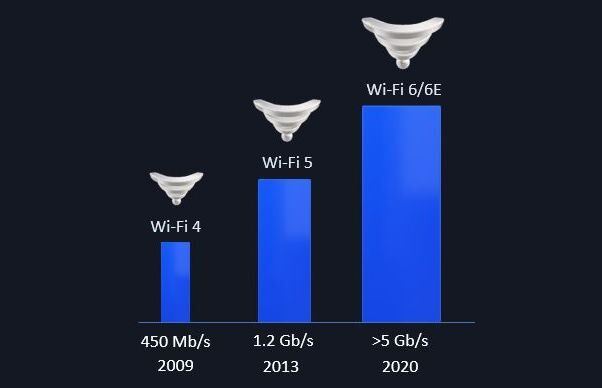“The Wi-Fi Alliance called the decision by the Federal Communications Commission (FCC) to open 1,200 MHz of spectrum in the 6 GHz band for unlicensed use “historic and visionary” and likely to “transform wireless connectivity for decades to come”. This game‑changing vote, which took place on April 23, 2020, paved the way for broad market adoption of Wi-Fi 6E devices.
Wi-Fi 6E is the new Wi-Fi Alliance terminology for IEEE 802.11ax devices that are capable of operating at 6 GHz, as well as in the 2.4 GHz and 5 GHz spectra already used by Wi-Fi 6 for transmission. The key point here is that Wi‑Fi 6E isn’t a new wireless protocol; rather it’s an expansion of current Wi‑Fi 6 technology into a new and much wider radio frequency band. This capability will reduce latency because there aren’t existing Wi-Fi devices competing for bandwidth in the newly opened spectrum. Likewise, transmission speeds, even when obstructions are present, will significantly increase. Opening the 6 GHz portion of the spectrum increases the total spectrum currently available for Wi-Fi operation on both 2.4 GHz and 5 GHz bands by a factor of roughly five times. This is enough spectrum to offer seven additional completely non-overlapping 160 MHz wide channels or fourteen non‑overlapping 80 MHz wide channels. Wi‑Fi 6E devices are expected to become available quickly as only small changes to the antennae and front ends on existing Wi‑Fi 6 devices are required.

Since the 6 GHz Wi-Fi 6E enhancement essentially facilitates implementation of the existing Wi‑Fi 6 protocol, there’s no change to the theoretical maximum transmission rate of 9.6 Gb/s or the often-referenced “real world” transmission rate of greater than 5 Gb/s for this application. As a result, there’s no change to Siemon’s recommendation that two category 6A or higher performing cabling drops be available at every wireless access point. This recommendation is also repeated in the recently published TIA-568.0-E Generic and TIA-568.1-E Commercial Building telecommunications cabling Standards.
It’s important to keep in mind that the FCC is an independent agency of the United States government. So, while the outcome of their vote cleared the way for Wi-Fi 6E in the USA, other countries have had to make similar regulatory decisions. The good news is that communications agencies in China, Japan, South Korea, Brazil, Germany, the U.K., France, Canada, and Saudi Arabia have already agreed to open the necessary spectrum to support Wi-Fi 6E. Many more countries are anticipated to adopt this change in the months to come.

Dave Valentukonis
North America Technical Services Manager, Siemon
Dave Valentukonis joined Siemon in 1995 and has held positions in Technical Support and Product Management. He is currently the North American Technical Services Manager where he oversees an experienced team of product, application, training, and technology experts that help Siemon customers navigate a diverse and rapidly changing market. He is a BICSI RCDD/NTS and an active member of TIA.




